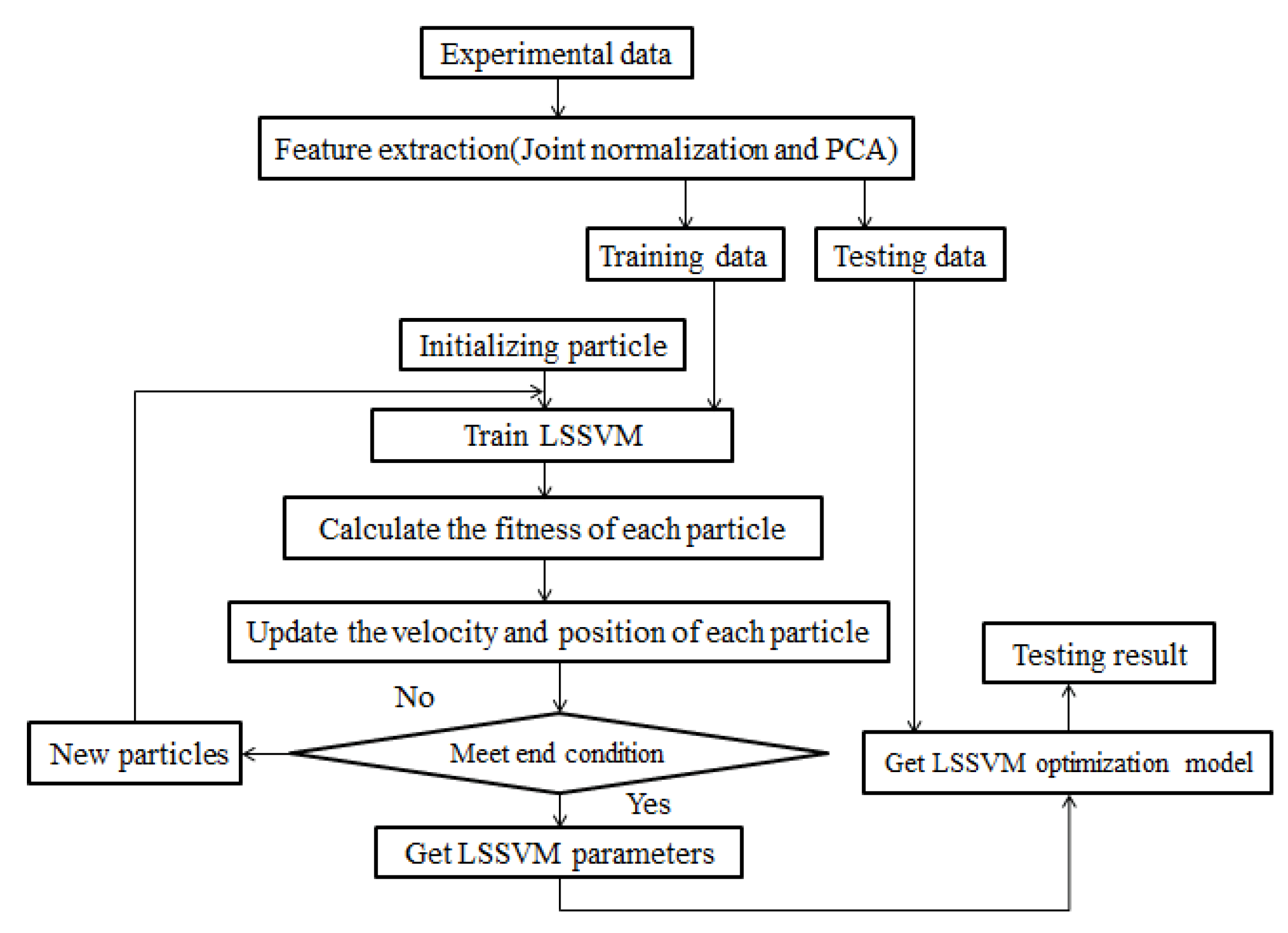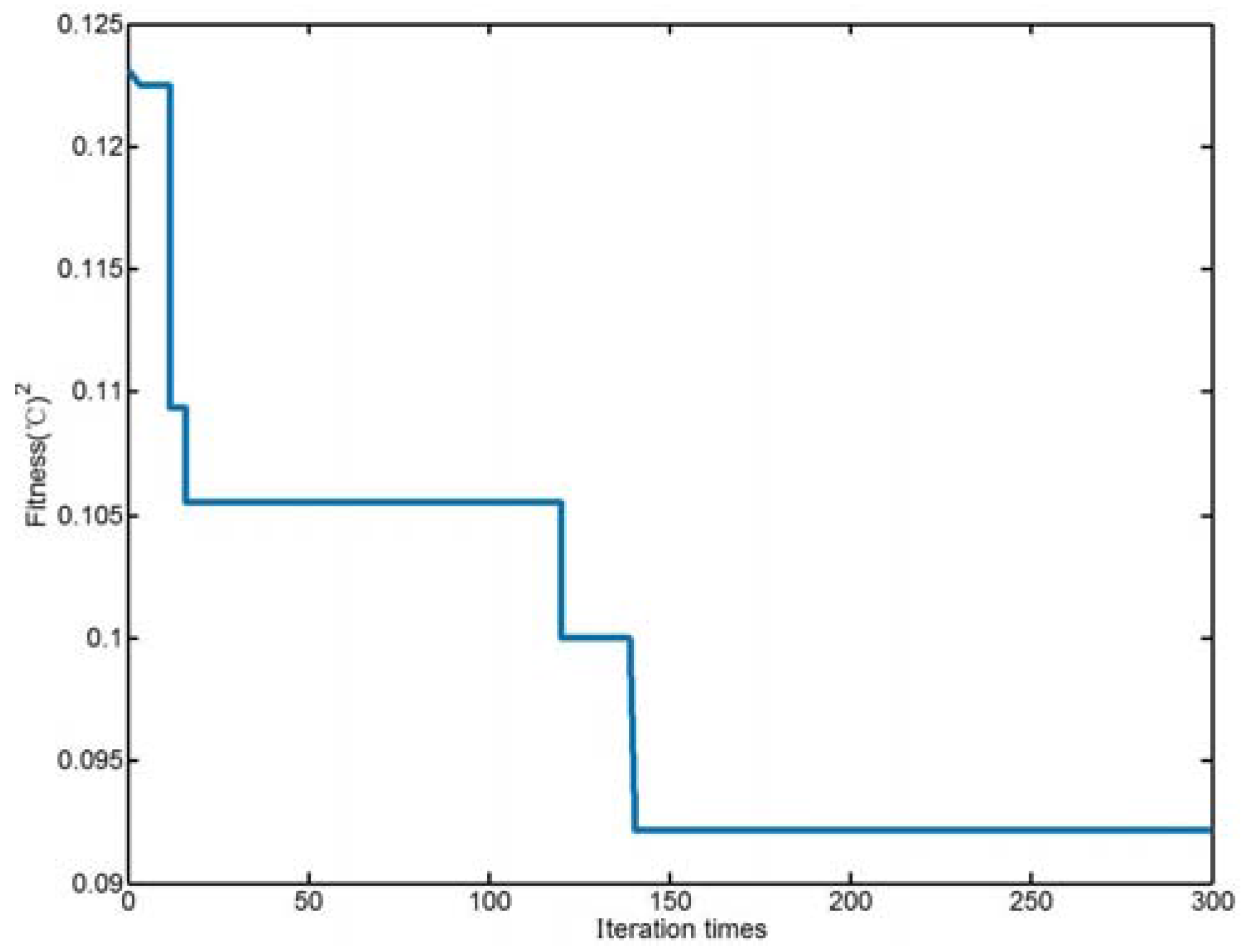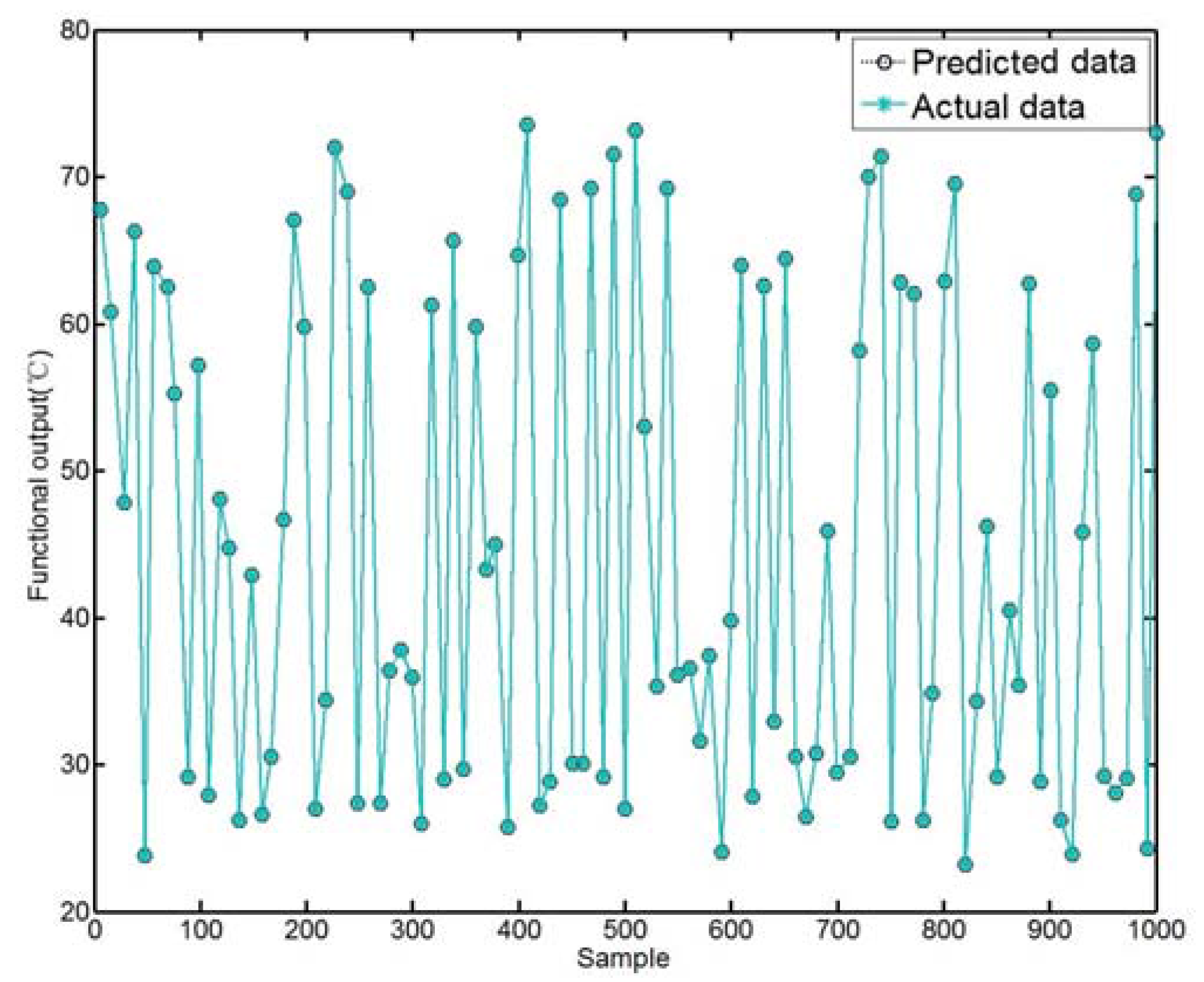The Use of an Improved LSSVM and Joint Normalization on Temperature Prediction of Gearbox Output Shaft in DFWT
Abstract
:1. Introduction
2. The Related Theories
2.1. LSSVM and Pruning Algorithm
2.1.1. LSSVM Prediction Algorithm
2.1.2. LSSVM Pruning Algorithm
- (1)
- Setting n = ntot, which is the number of training samples.
- (2)
- According to LSSVM algorithm, ak is calculated.
- (3)
- The obtained ak is sorted according to its absolute value.
- (4)
- According to the value of ak, m samples are deleted corresponding to the smaller ak (in general, m is 5–10% of the number of training samples).
- (5)
- Keep the remaining n − m samples and set n = n − m.
- (6)
- Return (2) to retrain the model using the reduced set of samples, until the generalization ability of the classifier required by the user begins to drop.
2.2. Joint Normalization of Data
- (1)
- Column vectors normalization. Maximum-minimum standardized method is selected to carry out the column vectors normalization in this paper.
- (2)
- Row vectors normalization. Maximum-minimum standardized method is also selected to carry out the row vectors normalization in this paper.
2.3. PCA Dimension Reduction Processing
2.4. PSO Algorithm
2.5. Forecasting Evaluation Index
3. Temperature Prediction of High-Speed Output Shaft Based on Pruning LSSVM
3.1. The Proposed Prediction Model
3.2. Predictive Example
3.3. Comparative Analysis of Prediction Results
4. Conclusions
Acknowledgments
Author Contributions
Conflicts of Interest
References
- Xiao, Y.; Wang, Y.; Mu, H.; Kang, N. Research on misalignment fault isolation of wind turbines based on the mixed-domain features. Algorithms 2017, 10, 67. [Google Scholar] [CrossRef]
- Xiao, Y.; Kang, N.; Hong, Y.; Zhang, G. Misalignment fault diagnosis of DFWT based on IEMD energy entropy and PSO-SVM. Entropy 2017, 19, 6. [Google Scholar] [CrossRef]
- Crabtree, C.J.; Feng, Y.; Tavner, P.J. Detecting incipient wind turbine gearbox failure: A signal analysis method for on-line condition monitoring. In Proceedings of the European Wind Energy Conference, Warsaw, Poland, 20–23 April 2010. [Google Scholar]
- Guo, P.; Bai, N. Wind turbine gearbox condition monitoring with AAKR and moving window statistic methods. Energies 2011, 4, 2077–2093. [Google Scholar] [CrossRef]
- Kostandyan, E.E.; Sørensen, J.D. Reliability assessment of solder joints in power electronic modules by crack damage model for wind turbine applications. Energies 2011, 4, 2236–2248. [Google Scholar] [CrossRef]
- Liu, Z.; Zhang, P.; Shen, Y. Thermal analysis model of high speed cylindrical roller bearing. Mech. Sci. Technol. 2000, 16, 607–611. [Google Scholar]
- Zhang, J.; Li, Y. Selection and simulation of input variables in the temperature prediction of wind turbine gearbox. J. Xi’an Technol. Univ. 2015, 4, 340–344. [Google Scholar]
- Kusiak, A.; Verma, A. Analyzing bearing faults in wind turbines: A data-mining approach. Renew. Energy 2012, 48, 110–116. [Google Scholar] [CrossRef]
- Schlechtingen, M.; Santos, I.F. Comparative analysis of neural network and regression based condition monitoring approaches for wind turbine fault detection. Mech. Syst. Signal Process. 2011, 25, 1849–1875. [Google Scholar] [CrossRef] [Green Version]
- Guo, P.; David, I.; Yang, X. Wind turbine gearbox condition monitoring using temperature trend analysis. Chin. J. Electr. Eng. 2011, 31, 129–136. [Google Scholar]
- Guo, P.; Infield, D.; Yang, X.Y. Wind turbine generator condition-monitoring using temperature trend analysis. IEEE Trans. Sustain. Energy 2012, 3, 124–133. [Google Scholar] [CrossRef]
- Wang, Z.; Guo, P. Wind turbine spindle condition monitoring based on operational data. In Proceedings of the 29th Chinese Control and Decision Conference, Chongqing, China, 28–30 May 2017; pp. 1435–1440. [Google Scholar]
- Zhang, X.; Yan, S.; Zhou, X.; Zhao, H. Early fault prediction method for main bearing of wind turbine based on state monitoring. Guangdong Power 2012, 11, 7–50. [Google Scholar]
- Zhao, H.; Zhang, X. Early fault prediction of wind turbine gearbox based on temperature measurement. In Proceedings of the 2012 IEEE International Conference on Power System Technology, Auckland, New Zealand, 30 October–2 November 2012; p. 5. [Google Scholar]
- Shin, J.; Lee, Y.; Kim, J. Fault prediction of wind turbine by using the SVM method. In Proceedings of the 2014 International Conference on Information Science, Electronics and Electrical Engineering, Sapporo, Japan, 26–28 April 2014; pp. 1923–1926. [Google Scholar]
- Fang, R.; Jiang, S.; Shang, Y.; Wang, L. On line assessment of the wind turbine gearbox state using the trend state analysis. J. Huaqiao Univ. 2016, 37, 32–37. [Google Scholar]
- Li, H.; Li, X.; Hu, Y.; Yang, C.; Zhao, B. Unequal interval grey prediction of wind turbine operation state parameters. Power Syst. Autom. 2012, 36, 29–34. [Google Scholar]
- He, F.; Zhou, C.; Liu, C. Application of BP neural network in predicting solar greenhouse soil temperature. Int. Agric. Eng. J. 2016, 25, 175–183. [Google Scholar]
- Ma, Z.; Zhao, Z.; Huang, W. Stepwise regression analysis of the melting point of the coal ash in Ruqigou. Coal Geol. China 2010, 22, 7–9. [Google Scholar]
- Xu, J.; Liu, X.; Li, D.; Zhou, Z.; Wang, F.; Yu, G. Study on temperature prediction model of coal ash flow. J. Fuel Chem. 2012, 40, 1415–1421. [Google Scholar]
- Niu, M.; Sun, Y.; Lin, B. Study on calculation formula of coal ash melting temperature. Coal Qual. Technol. 2011, 17, 69–72. [Google Scholar]
- Xu, Z.; Zheng, J.; Wen, X. Prediction of ash fusion point based on partial least squares regression. J. Power Eng. 2010, 30, 788–792. [Google Scholar]
- Zhang, Y.; Yin, Y.; Wang, X. Model for predicting ash melting point of coal ash composition. Sized Nitrogenous Fertil. Prog. 2012, 6, 10–12. [Google Scholar]
- Li, J.; Shen, B.; Li, H.; Zhao, J.; Wang, J. Effect of coal blending on the melting point of coal ash and the prediction model of ash melting point. Coal Qual. Technol. 2009, 5, 66–70. [Google Scholar]
- Kahramanac, H.; Bos, F.; Reifenstein, A. Application of a new ash fusion test to theodore coals. Fuel 1998, 77, 1005–1011. [Google Scholar] [CrossRef]
- Zhang, D.; Long, Y.; Gao, J.; Zhang, B. The relationship between chemical composition of coal ash and ash fusibility. J. East China Univ. Sci. Technol. 2003, 29, 590–594. [Google Scholar]
- Fan, Q.; Pan, P. Analysis of correlation between chemical composition and melting temperature and melting temperature. Boil. Technol. 2007, 38, 10–13. [Google Scholar]
- Cao, X.; Li, H.; Liu, J.; Zhang, Z.; Zhu, B.; Zhao, Q. Effect of mineral concentrate on the melting characteristics of coal ash and its melting mechanism. J. Coal Sci. 2013, 38, 314–319. [Google Scholar]
- Ren, H.; Lei, X.; Zhang, P. A study of wind speed prediction based on particle swarm algorithm to optimize the parameters of sparse least squares support vector. Int. J. Simul. 2016, 17, 1.1–1.7. [Google Scholar]
- Ye, M.; Wang, X.; Zhang, H. Chaotic time series prediction based on online least squares support vector regression. Phys. J. 2005, 54, 2568–2573. [Google Scholar]
- Hemmati-Sarapardeh, A.; Varamesh, A.; Husein, M.M.; Karan, K. On the evaluation of the viscosity of nanofluid systems: Modeling and data assessment. Renew. Sustain. Energy Rev. 2018, 81, 313–329. [Google Scholar] [CrossRef]
- Ahmadi, M.A.; Rozyn, J.; Lee, M.; Bahadori, A. Estimation of the silica solubility in the superheated steam using LSSVM modeling approach. Environ. Prog. Sustain. Energy 2016, 35, 596–602. [Google Scholar] [CrossRef]
- Liu, C.; Niu, P.; Li, G.; You, X.; Ma, Y.; Zhang, W. A hybrid heat rate forecasting model using optimized LSSVM based on improved GSA. Neural Process. Lett. 2017, 45, 299–318. [Google Scholar] [CrossRef]
- Yi, L.; Niu, D.; Ye, M.; Hong, W. Short-term load forecasting based on wavelet transform and least squares support vector machine optimized by improved cuckoo search. Energies 2016, 9, 827. [Google Scholar] [CrossRef]
- Yang, J.; Cheng, Y.; Huang, J. A novel short-term multi-input-multi-output prediction model of wind speed and wind power with LSSVM based on quantum-behaved particle swarm optimization algorithm. Chem. Eng. Trans. 2017, 59, 871–876. [Google Scholar]
- Liu, X. Research on normalization of input layer data of BP neural network. Mechan. Eng. Autom. 2010, 3, 123–126. [Google Scholar]
- Santos-Alamillos, F.J.; Thomaidis, N.S.; Quesada-Ruiz, S.; Ruiz-Arias, J.A.; Pozo-Vázquez, D. Do current wind farms in Spain take maximum advantage of spatiotemporal balancing of the wind resource. Renew. Energy 2016, 96, 574–582. [Google Scholar] [CrossRef]
- Zhang, W.; Ma, D.; Wei, J.J.; Liang, H. A parameter selection strategy for particle swarm optimization based on particle positions. Expert Syst. Appl. 2014, 41, 3576–3584. [Google Scholar] [CrossRef]
- Pousinho, H.M.I.; Catalao, J.P.S.; Mendes, V.M.F. Wind power short-term prediction by a hybrid PSO-ANFIS approach. In Proceedings of the Melecon 2010–2010 15th IEEE Mediterranean Electrotechnical Conference, Valletta, Malta, 25–28 April 2010; pp. 955–960. [Google Scholar]
- Sun, P.; Li, J.; Chen, J.; Lei, X. A short-term outage model of wind turbines with doubly fed induction generators based on supervisory control and data acquisition data. Energies 2016, 9, 882. [Google Scholar] [CrossRef]



| Method | Characteristic | Advantages | Disadvantages |
|---|---|---|---|
| BP neural network | It is a nonlinear regression method, which has strong nonlinear mapping ability [18]. | The adaptability is strong. The forecasting precision is high, and the modeling process is more convenient and direct. It is not necessary to specify the direct relationship between input and output. | It requires huge data samples. Less samples cannot get accurate results. |
| Nonlinear state estimation | A method for estimating the internal state of a dynamic system based on measured data. | Non parametric modeling method. Clear physical meaning. | Low accuracy. Poor implementation. |
| Linear regression method | The curve is fitted by using various algorithms, including stepwise regression method [19,20,21,22], piecewise fitting method [23,24], regression analysis fitting [25], partial least squares regression [26,27], least squares regression [28]. | Operation is more convenient. | The adaptability of the prediction model is poor, only in the proper scope it has a good prediction effect. |
| Support vector machine | It has many unique advantages in solving a few, nonlinear and high dimensional samples. | The prediction precision is high and the samples are relatively a few. | The choice of parameters affects the accuracy of the model. |
| Gray model | Based on the generated data, but not the original data. | Do not need a lot of samples. There is small amount calculation. | It is better for predicting data with definite trends. |
| Nacelle Vibration x (mm) | Nacelle Vibration y (mm) | Wind Speed (m/s) | Rotor Speed (r/min) | Gearbox Tempera-Ture Input Shaft (°C) | Gearbox Tempera-Ture Output Shaft (°C) | Gearbox Oil Tempera-Ture (°C) | Grid Power (KW) | Main Bearing Gearbox Side Temperature (°C) |
|---|---|---|---|---|---|---|---|---|
| −0.00779748 | −0.002426243 | 9.285114 | 12.84335 | 62.9 | 64.9 | 56.8 | 316.8 | 40.5 |
| −0.004867697 | 0.007827997 | 9.329819 | 12.84534 | 62.1 | 64 | 55.8 | 318.6 | 40.3 |
| −0.001937914 | −0.000473023 | 9.821562 | 12.92032 | 61.2 | 63.3 | 55 | 316.8 | 40.1 |
| −0.000961351 | 0.004898214 | 8.916306 | 12.98766 | 60.3 | 62.7 | 54.6 | 316.8 | 39.9 |
| −0.000961351 | −0.003402805 | 10.03391 | 13.04737 | 59.6 | 62.1 | 54.1 | 315.6 | 39.7 |
| −0.003891087 | 0.00148015 | 11.45326 | 12.95979 | 59.1 | 61.6 | 53.6 | 314.4 | 39.5 |
| −0.002914524 | −0.002914524 | 8.234571 | 13.04737 | 58.7 | 61.1 | 53 | 316.2 | 39.4 |
| −0.001937914 | 0.008316278 | 11.17386 | 13.01453 | 58.5 | 60.6 | 51.8 | 315.6 | 39.3 |
| 0.00050354 | −0.007309198 | 11.49796 | 12.9369 | 58.6 | 60.1 | 50.3 | 319.2 | 39.1 |
| −0.000473023 | −0.001937914 | 11.59855 | 13.09713 | 59.4 | 61.2 | 53.6 | 325.2 | 39 |
| Nacelle Vibration x | Nacelle Vibration y | Wind Speed | Rotor Speed | Gearbox Tempera-Ture Input Shaft | Gearbox Tempera-Ture Output Shaft | Gearbox Oil Tempera-Ture | Grid Power | Main Bearing Gearbox Side Tempera-Ture |
|---|---|---|---|---|---|---|---|---|
| 0.282 | 0.049 | 0.601 | 0.469 | 0.55 | 0.491 | 0.510 | 0.591 | 0.898 |
| 0.128 | 0.575 | 0.608 | 0.469 | 0.505 | 0.448 | 0.439 | 0.589 | 0.864 |
| 0.02 | 0.150 | 0.693 | 0.478 | 0.455 | 0.414 | 0.382 | 0.591 | 0.830 |
| 0.025 | 0.425 | 0.537 | 0.486 | 0.405 | 0.386 | 0.354 | 0.591 | 0.796 |
| 0.076 | 1.279 | 0.730 | 0.492 | 0.366 | 0.357 | 0.319 | 0.593 | 0.762 |
| 0.076 | 0.250 | 0.974 | 0.482 | 0.338 | 0.333 | 0.283 | 0.594 | 0.728 |
| 0.076 | 0.025 | 0.419 | 0.492 | 0.316 | 0.309 | 0.241 | 0.592 | 0.711 |
| 0.025 | 0.599 | 0.926 | 0.489 | 0.305 | 0.285 | 0.156 | 0.593 | 0.694 |
| 0.025 | 0.199 | 0.982 | 0.480 | 0.311 | 0.261 | 0.049 | 0.588 | 0.661 |
| 0.153 | 0.075 | 1 | 0.498 | 0.355 | 0.314 | 0.283 | 0.580 | 0.644 |
| Serial Number | Characteristic Value | Contribution Rate | Cumulative Contribution Rate |
|---|---|---|---|
| 1 | 4.938 | 54.861% | 54.861% |
| 2 | 1.350 | 15.004% | 69.865% |
| 3 | 1.198 | 13.312% | 83.178% |
| 4 | 0.681 | 7.563% | 90.740% |
| 5 | 0.617 | 6.859% | 97.599% |
| 6 | 0.186 | 2.065% | 99.664% |
| 7 | 0.016 | 0.178% | 99.841% |
| 8 | 0.010 | 0.116% | 99.957% |
| 9 | 0.004 | 0.116% | 100% |
| Method | Time(s) | t-Test | Accuracy of Error within ±5 °C | Accuracy of Error within ±10 °C | Mean Absolute Percentage Error (MAPE) | Mean Squared Error (MSE) |
|---|---|---|---|---|---|---|
| LSSVM (normalized with maximum-minimum method) | 4.958 | 0.0037 | 75% | 78% | 7.3% | 7.6% |
| LSSVM (normalized with peak method) | 4.957 | 0.0045 | 76% | 79% | 7.4% | 7.5% |
| LSSVM (normalized with value method) | 4.976 | 0.0054 | 78% | 80% | 7.2% | 7.1% |
| LSSVM (joint normalization) | 3.675 | 0.0056 | 80% | 82% | 6.5% | 6.8% |
| PCA-LSSVM (normalized with maximum-minimum method) | 3.567 | 0.0067 | 78% | 79% | 6.5% | 6.5% |
| PCA-LSSVM (normalized with peak method) | 3.987 | 0.0034 | 79% | 80% | 6.4% | 6.4% |
| PCA-LSSVM (normalized with value method) | 3.765 | 0.0045 | 81% | 82% | 6.3% | 6.2% |
| PCA-LSSVM (joint normalization) | 2.345 | 0.0056 | 83% | 84% | 5.6% | 5.8% |
| PSO-PCA-LSSVM (normalized with maximum-minimum method) | 3.125 | 0.0034 | 81% | 84% | 5.6% | 5.7% |
| PSO-PCA-LSSVM (normalized with peak method) | 3.135 | 0.0065 | 83% | 86% | 5.4% | 5.9% |
| PSO-PCA-LSSVM (normalized with value method) | 3.173 | 0.0075 | 82% | 85% | 5.2% | 5.1% |
| PSO-PCA-LSSVM (joint normalization) | 2.473 | 0.0064 | 85% | 87% | 4.7% | 4.9% |
| Pruning PSO-PCA-LSSVM (normalized with maximum-minimum method) | 2.348 | 0.0036 | 84% | 91% | 4.6% | 4.4% |
| Pruning PSO-PCA-LSSVM (normalized with peak method) | 2.475 | 0.0065 | 83% | 92% | 4.7% | 4.5% |
| Pruning PSO-PCA-LSSVM (normalized with value method) | 2.725 | 0.0076 | 85% | 92% | 4.3% | 4.2% |
| Pruning PSO-PCA-LSSVM (joint normalization) | 2.124 | 0.0045 | 90% | 93% | 3.7% | 3.8% |
| SVM | 6.453 | 0.1576 | 70% | 85% | 5.8% | 8.9% |
© 2017 by the authors. Licensee MDPI, Basel, Switzerland. This article is an open access article distributed under the terms and conditions of the Creative Commons Attribution (CC BY) license (http://creativecommons.org/licenses/by/4.0/).
Share and Cite
Xiao, Y.; Dai, R.; Zhang, G.; Chen, W. The Use of an Improved LSSVM and Joint Normalization on Temperature Prediction of Gearbox Output Shaft in DFWT. Energies 2017, 10, 1877. https://doi.org/10.3390/en10111877
Xiao Y, Dai R, Zhang G, Chen W. The Use of an Improved LSSVM and Joint Normalization on Temperature Prediction of Gearbox Output Shaft in DFWT. Energies. 2017; 10(11):1877. https://doi.org/10.3390/en10111877
Chicago/Turabian StyleXiao, Yancai, Ruolan Dai, Guangjian Zhang, and Weijia Chen. 2017. "The Use of an Improved LSSVM and Joint Normalization on Temperature Prediction of Gearbox Output Shaft in DFWT" Energies 10, no. 11: 1877. https://doi.org/10.3390/en10111877




